Resources
These show notes feature everything we cover in this episode. Premium Members: download this exclusive ad-free show notes cheat sheet PDF. Not a member yet? Learn more and join the Genealogy Gems and Elevenses with Lisa family here.

Opening your AncestryDNA account to find a New Ancestor Discovery can be a bit like the experience my nine-year old had at the beach today. He noticed something unusual in the sand on his way down to the beach and excitedly used his hands to unearth the treasure. However, it turned out to be a Captain Hook figurine long lost by another (likely much younger) beach-goer. His initial excitement quickly dissipated. He was disappointed as he had clearly found something he did not need or want.
I have heard from many of you that are confused and disappointed with Ancestry’s attempts to merge your genetics and your genealogy. Keep in mind that AncestryDNA matches are only using your genetics. Your DNA Circles and your New Ancestor Discoveries incorporate your linked tree into your genetic test results.
 Lisa recently forwarded me a comment from Kate that perfectly illustrates the confusion I’m talking about. “We had DNA done thru Ancestry,” she writes. “The results [have] made me seriously question what they are showing me. I believe they are using my tree to show me results that are more vague than they are revealing. The latest example they show is a person not related by blood. This family is related by name only (my uncle’s spouse).
Lisa recently forwarded me a comment from Kate that perfectly illustrates the confusion I’m talking about. “We had DNA done thru Ancestry,” she writes. “The results [have] made me seriously question what they are showing me. I believe they are using my tree to show me results that are more vague than they are revealing. The latest example they show is a person not related by blood. This family is related by name only (my uncle’s spouse).
“My results from Ancestry show that they use my tree to make matches. Just checked the web page for DNA results. They show numerous matches….Three or 4 contacted me because they were convinced they were related by blood when they may have had a remote tree connection. They contacted me because the DNA results showed they were a 3rd or 4th
cousin, when in fact they would only be a 3rd or 4th cousin in my tree.”
I can see why she’s confused. First, let’s review what an AncestryDNA New Ancestor Discovery (NAD) actually IS. NAD’s are based on the DNA Circle idea created by Ancestry. Remember that a DNA circle is when Ancestry can identify a shared genetic AND genealogical connection between three or more people. Using various standards and measures, they name an ancestor as your connection. This is the ancestor I affectionately call our Party Host. This is the ancestor who passed his or her DNA down to all of their descendants, like tickets inviting them to this party in the future. So, everyone who holds a ticket, AND who has honored that party host ancestor by placing their name in their pedigree chart, is listed as a guest in the form of a DNA circle connection. (Click here to read a blog post about this concept.)
The New Ancestor Discoveries just take that one step further. The NAD is an attempt to find ticket holders who have not yet taken that extra step and added that important Party Host ancestor to their family tree. The NAD is like a nudge, inviting us to double check our family tree to see if this particular ancestor might need to be added. It is important to remember that a NAD comes only after a DNA circle has already been formed, and there could have been errors in that formation. So the very first thing you need to do with a NAD is to correspond with circle members and double check that the Party Host of the circle, their common ancestor, is correct. Then we can move on to evaluating the NAD.
Ancestry admits on its help pages that there are three reasons why you might get an NAD, and only one is “right” in the way you and I might view it.
 The “right” answer comes when the DNA circle was drawn correctly, the Party Host properly identified, and your DNA connection is strong to two or more members of the circle. You are then able to verify through traditional genealogical methods that you are an actual descendant of the Party Host, holding that coveted ticket, shown in blue in this modified image from the AncestryDNA help page.
The “right” answer comes when the DNA circle was drawn correctly, the Party Host properly identified, and your DNA connection is strong to two or more members of the circle. You are then able to verify through traditional genealogical methods that you are an actual descendant of the Party Host, holding that coveted ticket, shown in blue in this modified image from the AncestryDNA help page.
There are two other alternatives.
 First, you are related to the NAD Party Host (the New Ancestor that was discovered) via marriage. In this second example from Ancestry’s help page, we see that your ancestor was married twice. The members of the DNA circle are descendants of her other marriage. Remember, that you do not share DNA with every member of the DNA circle. In this case, you share the purple DNA with a few members of the circle. But there are other members that share the blue. So the super computers at Ancestry first put all the blues together in a circle with the Party Host at the top. Then you come along with purple DNA that matches a few in the circle and their supercomputer erroneously assumes that you too must have been invited to this “blue” party, but in fact, the blue/purple members of the circle are double booked. They have been invited to both the blue and the purple party.
First, you are related to the NAD Party Host (the New Ancestor that was discovered) via marriage. In this second example from Ancestry’s help page, we see that your ancestor was married twice. The members of the DNA circle are descendants of her other marriage. Remember, that you do not share DNA with every member of the DNA circle. In this case, you share the purple DNA with a few members of the circle. But there are other members that share the blue. So the super computers at Ancestry first put all the blues together in a circle with the Party Host at the top. Then you come along with purple DNA that matches a few in the circle and their supercomputer erroneously assumes that you too must have been invited to this “blue” party, but in fact, the blue/purple members of the circle are double booked. They have been invited to both the blue and the purple party.
How can you fix this? If you can identify your purple Party Host, then you can add that person to your tree, and the trees of your DNA matches and likely then a new DNA Circle will form with the purple Party Host at its head, and the blue NAD will disappear.
 The other situation that many of you are seeing, especially those of you with ancestry from small communities, is demonstrated in Figure 3 of the Ancestry Help page, reproduced here. As you can see, this one is much more complicated. (In fact, the colors I added aren’t even quite accurate, as not all descendants of the blue NAD have the same blue, but rather different shades of blue depending on the segment they received- but this is a story for another post!)
The other situation that many of you are seeing, especially those of you with ancestry from small communities, is demonstrated in Figure 3 of the Ancestry Help page, reproduced here. As you can see, this one is much more complicated. (In fact, the colors I added aren’t even quite accurate, as not all descendants of the blue NAD have the same blue, but rather different shades of blue depending on the segment they received- but this is a story for another post!)
The short of it is, the members of the previously established DNA circle share one single ancestor with each other, but they share multiple separate and distinct ancestors with you. Looking at this chart it seems very clear, but remember, in the database we only see you and the people you match. We cannot tell from the DNA shared which piece came from which ancestor. So, it is very important to check and double check the pedigrees of those in the circle to identify additional shared lines.
The short of it is, these NAD’s are following the guilt by association rule, but in fact, you could be innocent. Just keep in mind the simple principle that you DO share a common ancestor with those members of the circle that you share DNA with. You do NOT necessarily share common ancestry with those in the circle that you do not share DNA with.
The key is to take these NAD’s for what they really are: research suggestions. Keep your expectations low, and then you will be pleasantly surprised when you are able to verify a connection.
 Ready to learn more about DNA testing for family history? Click here to watch two video interviews in which Lisa and I chat about genetic genealogy.
Ready to learn more about DNA testing for family history? Click here to watch two video interviews in which Lisa and I chat about genetic genealogy.
My DNA quick reference guides can get you started on your own DNA research, or help you unpuzzle and maximize results you don’t fully understand. Click here to see all six guides: purchase them individually or as value-priced bundles.
16 million Americans answered the call to serve their country during World War II and tragically over 400,000 never returned home. To honor them, each family of a fallen hero received a banner with a gold star to hang in their window. Now 80 years later, there’s another way to ensure they are honored and most importantly, not forgotten. Today the nonprofit Stories Behind the Stars focuses on researching and writing the stories of every one of the WWII fallen. In this special Veteran’s Day episode of Elevenses with Lisa, Don Milne, founder of Stories Behind the Stars joins me to discuss the project, how to access the stories, and how you can help with the research that ensures that every single one of the World War II fallen are remembered.
Watch Live: Thursday, November 11, 2021 at 11:00 am CT
(calculate your time zone)
(Get your ad-free Show Notes Cheat Sheet at the bottom of this page in the Resources section.) This article includes affiliate links. We will be compensated when you use our links at no additional charge to you. Thank you for supporting our free content!
16 million Americans answered the call to serve their country during World War II and tragically over 400,000 never returned home. To honor them, each family of a fallen hero received a banner with a gold star to hang in their window. Now 80 years later, there’s another way to ensure they are honored and most importantly, not forgotten.
Today the nonprofit Stories Behind the Stars focuses on researching and writing the stories of every one of the 421,000 US World War II fallen. I want to share with you how to find them, and how you can help with the research that ensures that every single one of the World War II fallen are remembered.
The Stories Behind the Stars founder Don Milne joins me in this video episode. He’s a lifelong history buff, and a few years ago he decided to write a daily story about one of the US World War II fallen for his blog called WW2 Fallen 100. His effort totaled more than 1,200 stories and has been read more than 1 ½ million times.
After his banking job was eliminated at the end of 2019, Don decided to devote his full time to create Stories Behind the Stars and find volunteers to write the stories of everyone of the 421,000 US World War II fallen.
Lisa: I’d love to start by putting the fallen heroes of World War II front and center. Can you share with us one of the stories that has really touched you?
Don: Yes. It’s harder and harder to do that because so far we’ve already done about 13,000 stories. One of the more recent ones that we’ve done on our Pearl Harbor project was a fellow named Don Whitestone. He was on the USS Arizona, the battleship totally decimated at Pearl Harbor. More than 1000 people were killed on that ship, and he was one of those. If you go to the USS Arizona Memorial, you just see a name on the wall. And that’s basically all you know about him.

USS Arizona (public domain)
So, for our project that we’re focusing on right now, is to tell the story of all the men lost at Pearl Harbor, all 2335 of them. We’ve already finished the one for Don Boydston.
Just to give you a little bit of information about him. We know he was from Fort Worth, Texas. He was the youngest of six children. Almost every one of his brothers also enrolled in the military during World War Two. His eldest brother survived the war. His second oldest brother, he was actually in Hawaii the same time as his younger brother. Don was there while he was on shore. So, he would have probably been looking for his brother right after the attack, and wouldn’t have found him because he didn’t survive and they never found his body. He ended up continuing in the military and rose to the rank of Lieutenant Colonel. And he received the Silver Star for leading his men against the Germans in France in 1944. He died in 1945 while the war was still going on.
Another brother by the name of Robert served as a lieutenant. He was wounded, but he survived the war and lived to be age 90.
Another brother by the name of Ward, he joined the Army Air Forces. He was on a mission to Tripoli in 1943, in his B24 Liberator, and his plane went down.
So, here’s a family of five brothers. Two of them survived the war, and three of them didn’t. One of them died the very first day of the war, Pearl Harbor, and one of them died during the very last year of the war. It must have been devastating to have a family of five sons and lose three of them. But the father of the family, he did something really interesting. He decided that he was going to write stories, to write letters to the servicemen that may not be getting letters, because back then there wasn’t any social media. You couldn’t pick up a cell phone and talk to people. You had to write letters. And that was like, the thing that all of the servicemen looked forward to is they wanted to get letters from home. And so he made it a project in 1942. He was going to write stories to servicemen who didn’t have someone writing to them. He wasn’t going to be able to write to his son Don because he died at Pearl Harbor. But rather than feel sorry for himself and live with that loss, he decided to write the letters for a long period throughout the war.
He started with 137 different soldiers that he wrote to on a regular basis. So, I think that’s a wonderful thing that I didn’t know about. And all of these men and women who didn’t come home from World War II deserve to be remembered by more than just seeing a name on a memorial or gravesite. So, there’s a lot more Don Boydstuns out there. What we’re trying to do is find volunteers that can help us find those stories.
Lisa: That’s such a fitting story. That father was making sure that the soldiers weren’t being forgotten. You’re in a way, of course, carrying that on today, through your project. And, as you listen to that story, you realize that you think you’re hearing one person’s story. But I’m hearing the story of the parents. I’m thinking about the mom. I just can’t imagine all the sons going to war and losing one. And so really, you’re capturing the stories of many more than the 421,000 fallen.
Read Don Boydstun’s story at Fold 3.
Lisa: What’s the mission of the Stories Behind the Stars project?
Don: The name of the project kind of tells what we’re doing. It is what they still do today. During World War II when a family lost a serviceman or woman during the conflict, they were given a banner with a gold star on it that they could hang in the window. We want to tell the stories behind those stars.
We have the World War II Memorial in Washington, DC. Th Price of Freedom monument carries that same motif. It has more than 4,000 individual stars, each one representing 100 of the fallen.
Stories behind the stars, our mission is pretty ambitious. We want to make sure that all 421,000 servicemen and women Army, Air Force, Army, Air Force, Navy, Marines, Coast Guard, Merchant Marines, every single one of them will have a story.
Part of the mission isn’t just to have it on some obscure website somewhere. But we want to have it available so anyone can read it at the memorial. It’s got to be super easy to find on a smartphone. That’s our mission. And the only way we can accomplish this is we need volunteers that are genealogy minded, that want to want to do this and do something more than just bring flowers to remember someone on Memorial Day. We’re looking for folks to create a permanent record that will go forward for decades to remember them.
The National Archives hosts the following casualty lists on their website:
Keep in mind that these lists are incomplete.
MyHeritage: Stories Behind the Stars volunteers often use MyHeritage’s photo enhancement and colorization tools on the photos included in the stories, in addition to their genealogy records. Visit MyHeritage.
Up until June 2021, all of the stories our volunteers have been writing were saved directly to Fold3. In the case of the Pearl Harbor project, it was decided to first save these stories to the Together We Served platform because it allows for some extra features not part of using Fold3. However, all TWS content is also shared over to Fold3.
Fold3 recently updated its user interface and this change did not include the automatic transfer of the stories from Together We Serve to Fold3. This is scheduled to happen by December 1, 2021. Once the update is complete, you will also be able to find stories like Don Boydstun’s story on Fold3.
The best place to search for all the completed Stories Behind the Stars stories is at the Stories Behind the Stars page at Fold3. Currently, the search only works for stories saved with the new Fold3 format. As previously mentioned, there are about 10,000 stories saved in the old format and Fold3 is converting those over.
The Pearl Harbor project webpage is still a work-in-progress, and writers are still working on the stories that have been researched. They have about 500 unassigned stories and anticipate a completion date of December 7. Until then, you can find stories at the D-Day page where there is a link that will take you to a page that separates the D-Day fallen by state. You will then find links showing a list of all D-Day fallen from each state.
You can help Stories Behind the Stars reach their goal of completing all the stories by the 80th anniversary of the end of WWII in September 2025 by writing one story a week. Visit Stories Behind the Stars and click the Volunteer button.
They occasionally share sample stories on their blog, as well as their podcast. This will help you get the idea of what these stories are like.
From Don: It does attract a lot of people with a genealogical background, but it’s not totally necessary. We’ve also got people with 40, 50 years of genealogy experience that they’re just wonderful at doing the research and stuff.
Basically, what we’re asking people to do is write a short story. We’re not writing a 40,000 word document. We’re basically writing short obituaries. Most obituaries are what 400 to 1000 words, and they just include basic information. And that’s what we’re basically trying to do.
The whole idea is we’re not creating stories that someone’s going to sit down and spend two hours reading. You’re going to go to a grave site, maybe you’re going to Normandy or Arlington, or your closest National Cemetery, where you see flags put out for all those that are in the military. The idea is you’re going to be able to take your smartphone and go up to that grave site and pull up a story and read it right there. Something that you can read in maybe five minutes or so. So pretty much everybody can write an obituary. Unfortunately, all of us probably will have to write an obituary sometime, right. That’s what we’re asking them to do.
We’ve created some training that gives people all the tools they need, so that they’ll feel really comfortable about writing these stories. And if they don’t consider themselves, writers, we have other ways that people can help. They can help with the database. Some people are better at editing than writing. So, we have people helping with that.
When researching the stories of the World War II fallen, Don recommends the following:
Organizations partnering with Stories Behind the Stars include Ancestry, MyHeritage, FamilySearch, Arlington National Cemetery, Friends of the National World War II Memorial, The National D-Day Memorial, JustServe.org, BillionGraves, and Together We Served.
From Don Milne:
1. Video Player (Live) – Watch live at the appointed time in the video player above.
2. On YouTube (Live) – Click the Watch on YouTube button to watch live at the appointed time at the Genealogy Gems YouTube channel. Log into YouTube with your free Google account to participate in the live chat.
3. Video Player above (Replay) – Available immediately after the live premiere and chat.
Please click here to sign up now if you haven’t already. You’ll receive a BONUS free eBook with your first email.
Please leave your questions and comments below.
Even if you don’t use Snagit, or if you’re a newbie or still deciding whether you want to use it, this video will give you tangible examples of what it can do for you. If you are already using Snagit, this session will definitely take your skills to the next level.
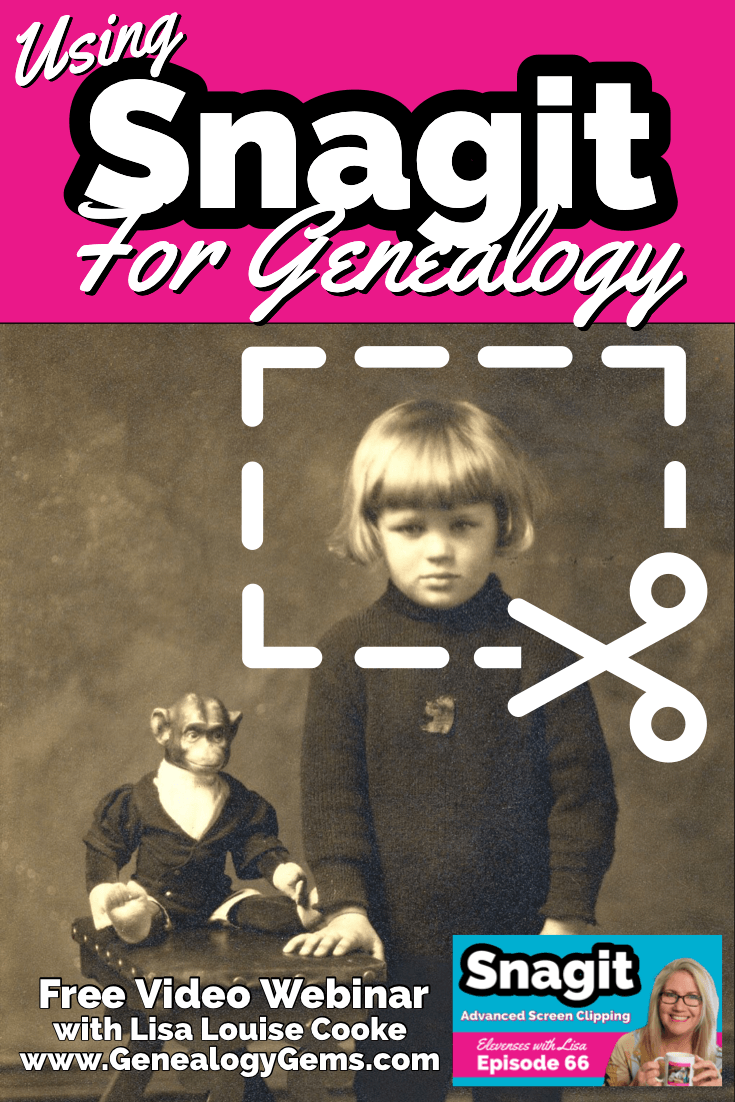
Use coupon code GENE15 to get 15% off. Thank you for using my link for purchasing your copy of Snagit. (We will be compensated at no additional cost to you, which makes the free Elevenses with Lisa show and notes possible.) Don’t worry if it initially shows as Euros in the cart. When you enter your address including country, it will convert the currency appropriately.
In Elevenses with Lisa episode 66 Lisa Louise Cooke will discuss how to use Snagit:
You can also watch at the Genealogy Gems YouTube channel.
Elevenses with Lisa episode 61 was a tutorial for beginners on how to use Snagit, and specifically how I use it for genealogy. I think it really resonated with genealogists because accurately and completely capturing the family information that we’re finding is absolutely essential for good source documentation. It’s one of the most important things we do as genealogists.
So, this video is sort of a “Part 2” session where we dig into more ways to use this amazing screen capture tool and I answer some of your most pressing questions.
Even if you use a different snipping tool, I’m going to give you tangible examples of how you can clip more effectively.
I received the following email from Anne W.: “I very much enjoyed your recent Elevenses with Lisa episode on how to use Snagit. I love the screen clipper on my Mac but this does so much more. I used your link to purchase Snagit and I have found the tutorials very helpful as I figure out how to use it on my Mac with my files. The first thing I did was go back to several newspaper pages I clipped recently in chunks and used Snagit to capture the whole page. It worked like magic! I would love to see another episode about the features of Snagit. Thank you for your regular and premium podcasts. I listen to both regularly. I have learned so much that I can apply to my genealogy research.”
Oh I love hearing how you’re using what we talk about here at Genealogy Gems! And yes, Snagit is fantastic for clipping those squirrely newspaper pages, and so much more!
Let’s get started – I’m excited to show you 5 more problem-solving screen capture projects that you can do with Snagit, and then we’ll wrap up with answers to your Snagit questions.
Bill in San Antonio, TX wrote me last week and told me about a problem that he was having with his online family tree at Ancestry It turns out that some ancestors had duplicate profiles. He didn’t put them there. He asked Ancestry about it but was getting what he called “boiler plate” answers that didn’t solve the problem.
In situations where you’re trying to communicate a complicated problem to someone else, or you’re just trying to work through it yourself, it can really help to visualize the problem, and Snagit can help you do that very effectively.
Bill says: “I am seeing duplicate FACTS in profiles of siblings, parents, and children of a person and cannot figure out where they originate. I go to the profile which seems to be generating duplicate information, but it is not there.”
As I read through all the details that he wrote up about the problem, I found myself getting confused. I asked his for access to his family tree so I could take a look and he wrote back
Bill went on to say, “The duplications I see are all in my tree. I have reviewed each of them to be certain that the data is not coming from a profile, even though it appears in duplicated form elsewhere.
Here is a screenshot of one such issue, showing two siblings with repeated data. Note that in each case, the birth location is slightly different, as in “Texas” vs. “Concho County, Texas”.
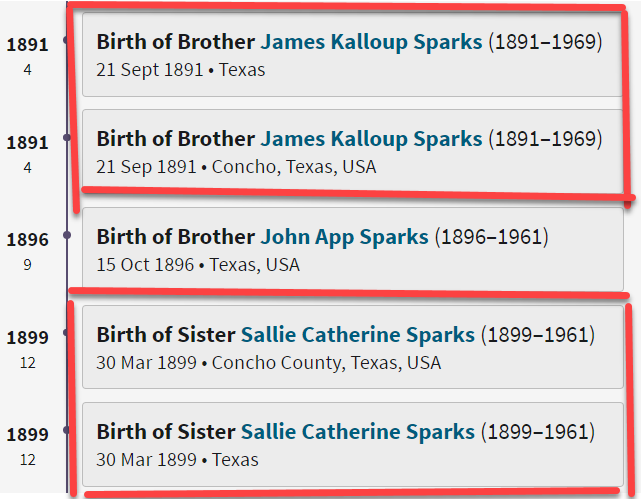
Ancestry Profile – problem of duplication
Bill had annotated his screen clipping to help me zero in on the problem. “(I used SnagIt for the screenshot — thanks for suggesting it!) I see this issue in other profiles, so your suggestions for solving it will be useful in other parts of the tree.”
Here are just three examples of ways you can highlight or call out an item in an image:
After you select and customization a style (such as a red outline shape) you will see that Snagit provides a “ghost” version of it in your list. It’s greyed out and ready to add. Simply click the plus sign to add the style to a theme. There are several themes available and you can create new themes.
I like to make it even faster to find the styles I use the most by adding them to my Favorites. It’s super easy to do. Just click the star on the style. You’ll find your Favorites in the star menu at the top of the screen.
As a side note, I do think this is a bug in Ancestry’s system. I recommended that he do the following to zero in on the problem:
Again, you can use Snagit to help work through things like this. Here’s how to see if you’re indeed looking at the same person: Right-click on each ancestor profile to open it in a new tab so you can compare and capture them. In this case it was Willie (the ancestor) and James and the duplicate of James. Each will have a URL address in your browser bar that will end in person/420009496764/facts. The number in red is the unique number for that person.
Had the tree number or person numbers been different, that would be the likely source of the problem. However, in Bill’s case, they are the same, so that’s more evidence that it’s a bug in Ancestry’s displaying of the information.
After screen capturing each profile they can be combined into one step-by-step document that can then be shared.
My guess is that at some point Bill viewed someone else’s tree or a hint that included this conflicting information, or he may have attached a record that had conflicting information, or rejected information from a record. In any case, some sort of action may have gotten “stuck” in the virtual stratosphere. The system has hung on to something it should not have. Bill says he’s finding more instances of this happening in the same tree, so it definitely needs to be addressed. It would be a shame to keep adding to the tree only to have that glitch continue to duplicate itself in other profiles.
I suggested looking through the records he has attached to James Kalloup Sparks to see if any of the attached records mention Concho, TX as his birthplace. I doubt there is one, but if there is, it is likely somehow linked to the problem.
It’s very odd that on Willie’s profile it shows James Kalloup Sparks’ birthplace as Concho in the duplication, but when you click that profile it doesn’t say Concho. It’s must surely be an Ancestry glitch.
If it were me, I would try downloading your tree and then creating a second tree by uploading it and seeing if the error still occurs. Here’s the Ancestry Help page.
Also, if by chance Bill was syncing his Ancestry online tree with genealogy software on his computer, there’s a possibility that could cause the problem.
Questions from Kelly: “Hi Lisa!, I would LOVE for you to create a very simple tutorial for adding in arrows and any text in “bubbles or boxes”. I have tried to do this and am missing something – I just LOVE Snagit but I am so technically challenged and would love to not become so annoyed when I am missing the simplest of steps.”
The most important thing to remember as you use annotations like text bubbles, shapes and text is you must select what you are working on. The font, color, sizing and other formatting features can be applied to every kind of annotation. You must select the item before applying the formatting.
If you’re ever confused about what “mode” you’re in, look at the top of the screen and note which tab is selected. In the example below, we are in “Shape” mode.
And if you try and try to make a change to an annotation and nothing seems to happen, you probably haven’t selected it. Click on the item to select it before attempting to make any changes.
If you want to move a item such as a shape or a selection of text, again you will need to click it to select it. You should see the “Move” selector handle that looks like this:
If you don’t or you’re having trouble, click “Move” in the toolbar at the top of the screen and then click on the item.
Most of the time if working with annotations or formatting them is presenting a challenge, it’s because the item hasn’t been properly selected before you begin.
Many of the most popular genealogy records websites offer a hinting feature that suggests records to you based on the information in your online family tree. Many of those “records” are quite unique. I recently came across a Photo Hint at Ancestry that was a screen capture of a story in a public Facebook group of the descendants of a particular couple. It was interesting information but I didn’t really want everything that was captured in the image. I used Snagit to capture and then edit the image the way I wanted it so I could then save it to my computer. This included erasing or removing unwanted areas. The following Snagit features can help you accomplish this easily:
Answers to your questions from episode 61 which was my beginning tutorial on Snagit. If you haven’t used it before stick with us in this video to see all the cool things it can do and then go back and watch that episode which is perfect for beginners.
Pat M.: Will OCR work for non-English newspapers?
Answer: Snagit doesn’t translate, but the OCR will Grab non-English text. Learn more here. You can then copy and paste it into Google Translate.
SHB: Don’t see Evernote on the list, how easy is it to save to EN?
Answer: If you have Evernote installed on your computer you should see it in the Share list. You can also download Evernote to add it as a Share destination. In fact, there are loads of programs you can download.
Cyndy B.: Are all these features in older versions?
Answer: No, like all software, each version introduces additional features.
SHB: Curious about printing… if you print a long article, will it print out readable?
Answer: Yes! You can set the resolution. And use Print Preview to make adjustments so it prints exactly the way you want it.
CA Sanders: if I bring a photo into Snagit and work with it will save IN Snagit, not in my original placement…so I would have to “save” or “move” to the folder it was in to begin with my changes.
Answer: After making your edits, use File > Save As to save it in the desired format to the desired location on your computer hard drive. You can also save it to replace the original if that’s your goal.
B Latham: How do we keep the SnagIt program up to date? It sounds as if other viewers here are saying they purchased the program a few years ago and may be outdated. Isn’t there a way to keep it up to date?
Answer: Yes, you can buy a maintenance plant that will include future updates at a reduced fee. Use our link and discount code, and the option will be available at checkout.
Barbara C.: For 2 different laptops, would we need to purchase Snagit twice?
Answer: TechSmith software is licensed per user, so how many computers can I install it on?
Each user may install and use one copy of the software product on up to two computers for their sole use, provided only one computer is in use at any given time. This includes home and work, or a laptop and desktop.
Here’s our link for purchasing your copy of Snagit (screen clipping tool) Thank you for using our link. Use coupon code: GENE15 (We will be compensated at no additional cost to you, which makes the free Elevenses with Lisa show and notes possible.)
These show notes feature everything we cover in this episode. Premium Members: download this exclusive ad-free show notes cheat sheet PDF. Not a member yet? Learn more and join the Genealogy Gems and Elevenses with Lisa family here.

The manufacturer price is going up August 31, 2021. Now’s the perfect time to get your official Elevenses with Lisa mug.
Click here to sign up now and you get your free bonus ebook.
Leave a Comment or Question Below
Adoption and genealogy often cross paths. More and more genealogists are having to navigating between both birth family and an adopted family pedigrees. Our easy, step-by-step instructions will show you how to merge these two pedigree charts into one with FamilySearch Family Tree and Ancestry.com.
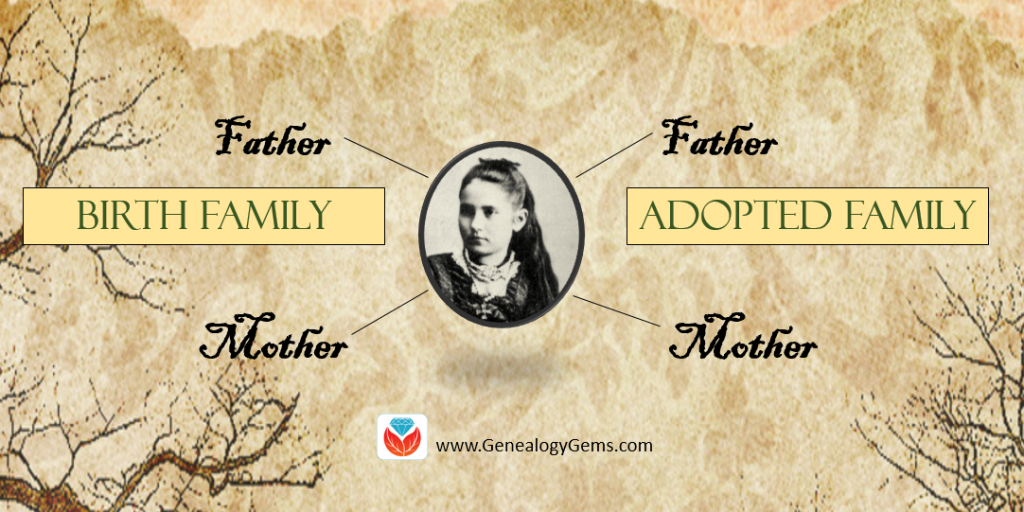
Anyone can create a family tree at FamilySearch.org for free. You need to create your free account first. If you need more instruction on how to get started with a family tree on FamilySearch, click here.
For those of you who already have a FamilySearch family tree you work with, here is how to include both a birth line and adopted line.
In this example below, James Donald Woodard was raised by Robert Cole and Goldie Witt, but is the natural son of Elmer Woodard and Margaret Cole.
Step 1: From the pedigree view, click on the person you would like to have two pedigrees for. Then, choose “Person” to get to the individual’s person page.
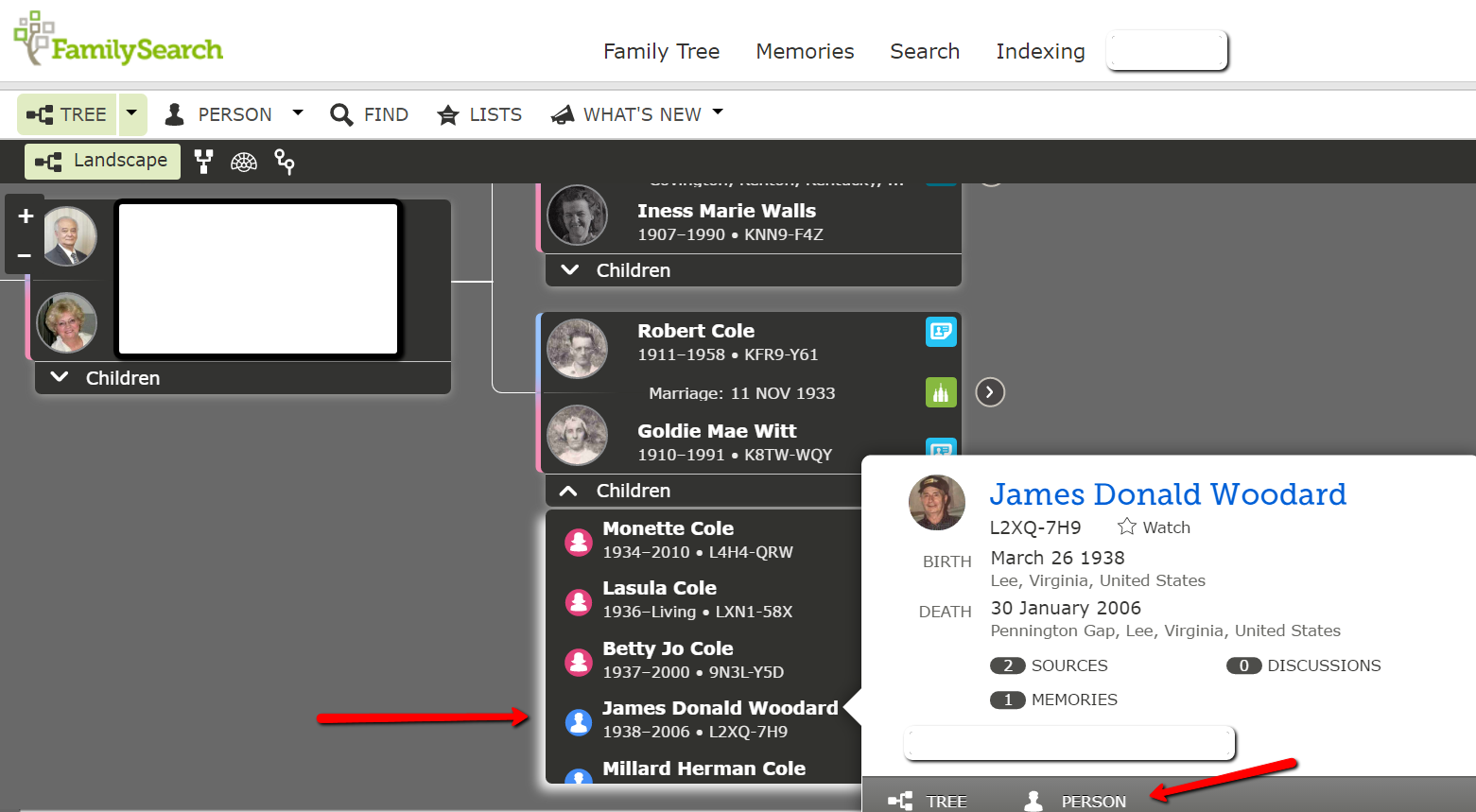
Step 2: At James’ person page, scroll down to the “parents and siblings” section. Here, multiple sets of parents can be added by clicking on “Add Parent.” We can also indicate what type of relationship the parent has to the child (choices include: biological, adopted, guardianship, foster, and step) by clicking the little pencil icon at the right of James’ name under the parent couple. Lastly, whichever couple is marked “preferred” will be the parents that will show up in your pedigree view.
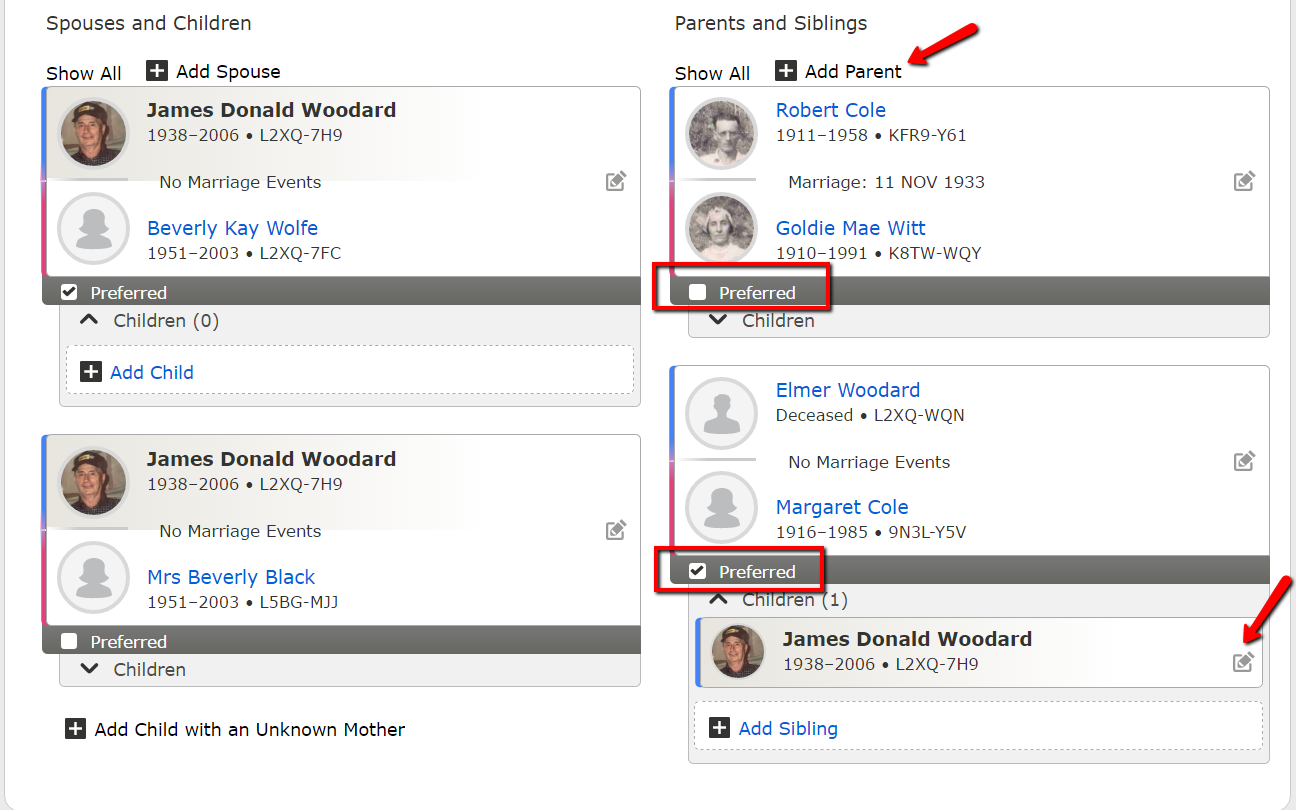
Step 3: Add a second set of parents for James by clicking on the “Add Parent” icon and follow the prompts to add the new parents by name.
Step 4: You will have James appearing as a child under each couple. Now, indicate the type of relationship James has with each couple.
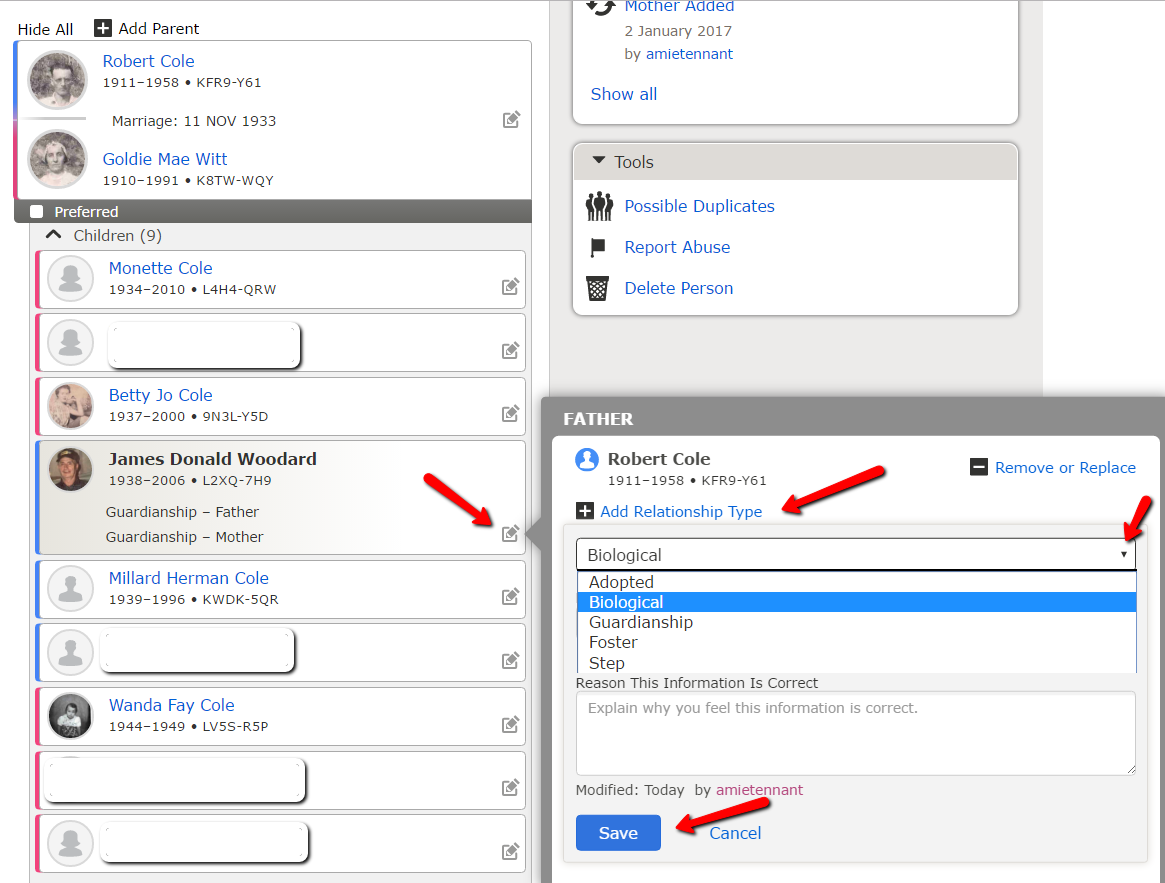
Find James in the list of children under Robert and Goldie.
Click on the little pencil icon in his box. A new window will pop-up. You will click on “Add Relationship Type” and then choose the appropriate relationship from the pull-down menu. When you are finished, click “Save.” You will need to do this for both the father and the mother.
You can see that James’ name appears under Robert and Goldie with the relationship noted. (When the relationship is biological, no notation appears.)
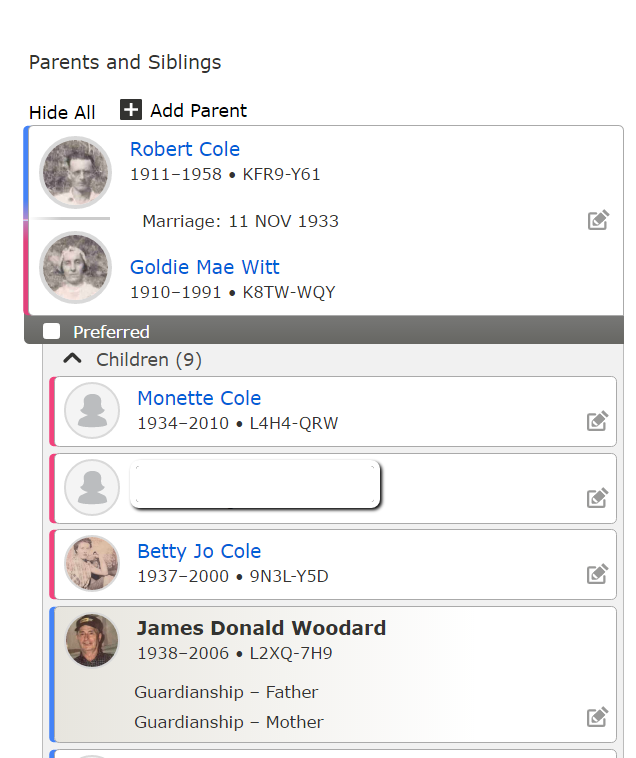
James now has two pedigree options. We can easily switch between the pedigrees for James by clicking the preferred button on whichever couple we would like to view. You can change the preferred couple whenever and how-many-ever times you want!
Step 1: First, add one set of parents for the individual. You can do this in the pedigree view. Click on “Add Father” or “Add Mother” and fill in the fields for name, date of birth, etc.

Step 2: Add a second set of parents for Jason by clicking on Jason’s name and choosing “Profile.” This takes you to a new screen that looks like this image below.
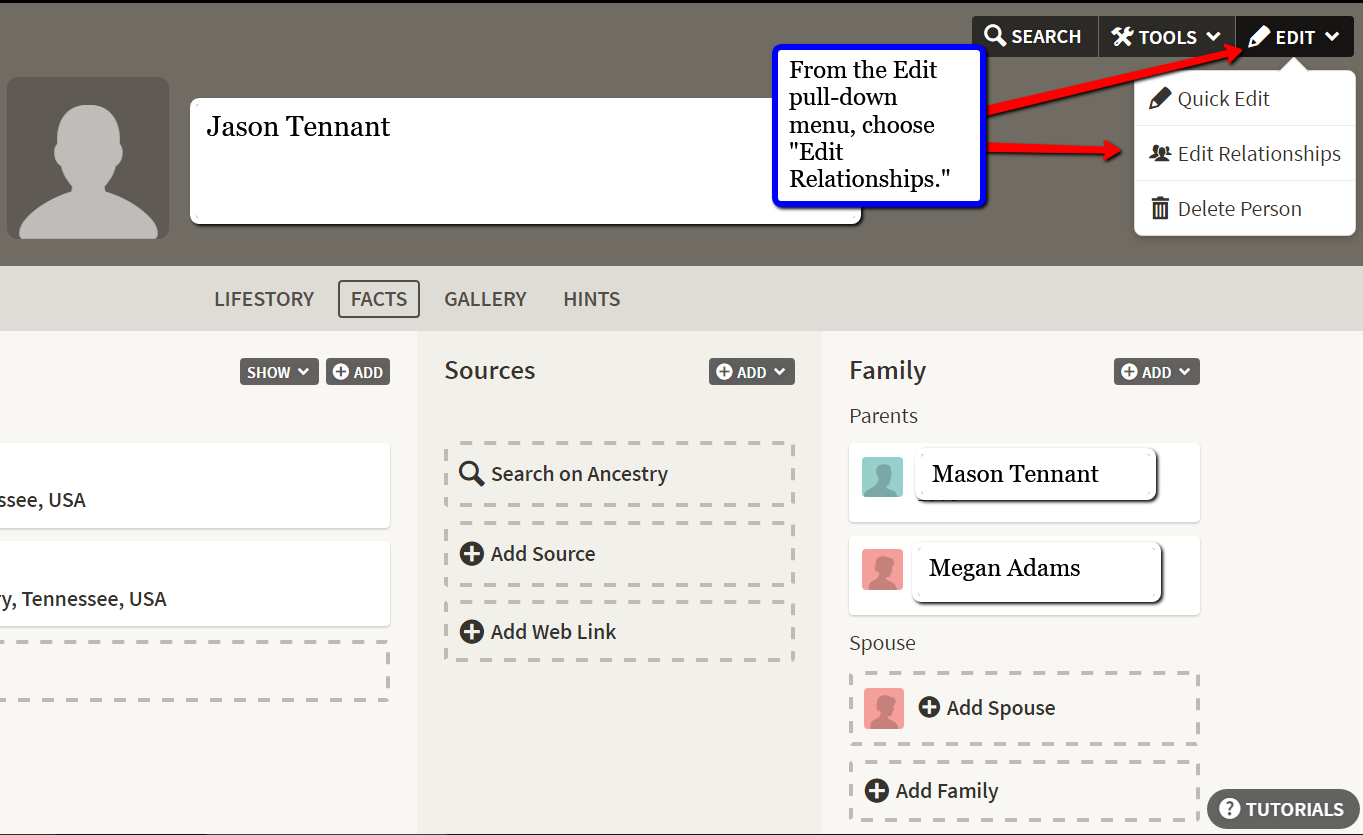
Step 3: This is Jason’s profile page. You can see his newly added parents, Mason Tennant and Megan Adams. Click the edit button at the top right of the screen and chose “Edit Relationships.”
Step 4: A pop-up window for relationships will appear. Here, you can mark the type of relationship between Jason and Mason. The choices are biological, adopted, step, related, guardian, private, and unknown. After you have chosen the appropriate relationship for the first father, click “Add Alternate Father.”

Step 5: Add the name of the second father and choose the appropriate relationship. You will then be able to choose which father you want to mark “preferred.” Do the same for the mothers.
If we want to see Jason’s birth or adopted family tree, we need only go to his profile page, click “Edit Relationships” at the top right, and mark one set of parents as “preferred.” Then, that couple will show up in the pedigree view.
Adoption genealogy certainly has it’s challenges, but creating a pedigree chart that includes both the birth and adoption lines, doesn’t have to be one of them! Let us know in the comments below how you have included both your birth and adoption lines into your family history. We love to hear from you.
DNA for Adoption Research: Nice to Meet You!
Genealogy Gems Podcast episode 178: CeCe Moore Talks about Genealogy and Adoption (Listen for free)